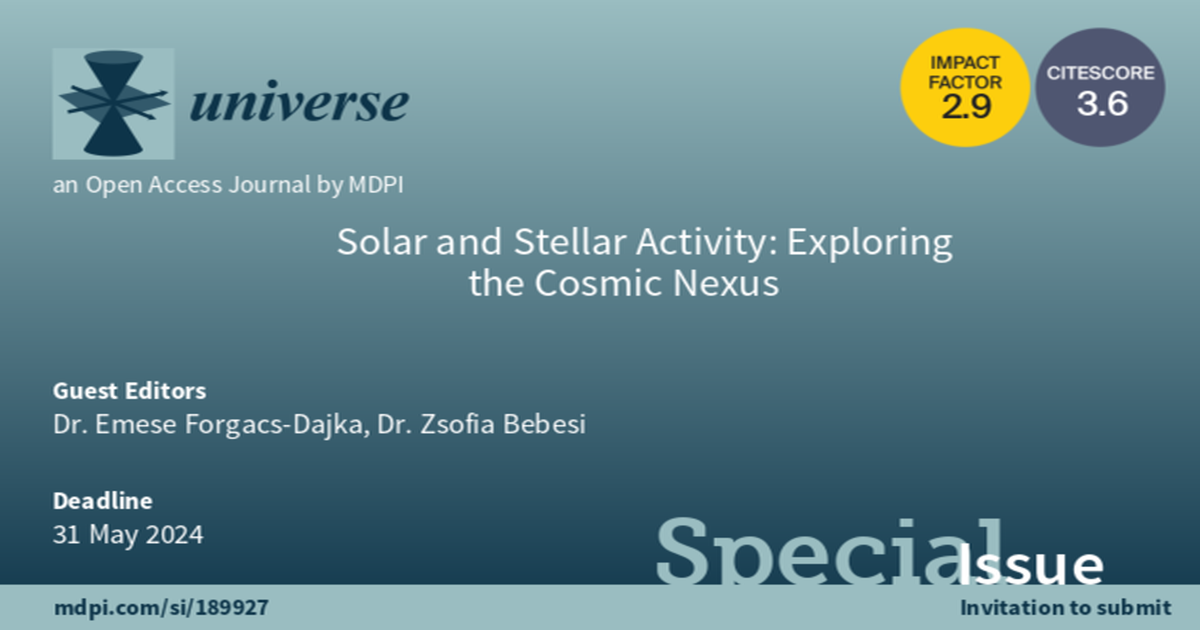Solar and Stellar Activity: Exploring the Cosmic Nexus
A special issue of Universe (ISSN 2218-1997). This special issue belongs to the section "Space Science".
Deadline for manuscript submissions: 31 May 2024 | Viewed by 518

Special Issue Editors
Interests: astrophysical HD/MHD; solar physics; planetary systems
Special Issue Information
Dear Colleagues,
Sun and the star activity is closely related to the cosmic environment in which they exist. This Special Issue on “Solar and Stellar Activity: Exploring the Cosmic Nexus” provides an opportunity to present the latest research on our Sun, its immediate environment (the heliosphere) and the activity of stars and its effects. Hence, the topic of this Special Issue is to review the variation and variability in various phenomena in space sciences. Sophisticated theoretical and numerical modeling techniques present a unique opportunity to combine several space and ground-based observations to understand the changes and connections in the surrounding space, from the nearest star (our Sun) to distant stars.
This following topics can be found in this Special Issue:
- The observation of magnetic phenomena in our Sun and other stars and their origin and evolution;
- The heating of solar and stellar coronae;
- The impact of activity phenomena on their environment in the heliosphere or in the astrospheres;
- Space weather prediction using coordinated observations of various spacecraft in the inner heliosphere, the vicinity of Earth and ongoing space missions at other planets;
- The effects of space weather on planets, comets and exoplanets.
The aim of this comprehensive Special Issue is to introduce exciting new solar and stellar research that has been gaining ground in recent years. The papers published here present new directions and highlight recent advances in the field, offering deeper insights into the role of space weather in relation with the complexity of stellar dynamics.
Dr. Emese Forgacs-Dajka
Dr. Zsofia Bebesi
Guest Editors
Manuscript Submission Information
Manuscripts should be submitted online at www.mdpi.com by registering and logging in to this website. Once you are registered, click here to go to the submission form. Manuscripts can be submitted until the deadline. All submissions that pass pre-check are peer-reviewed. Accepted papers will be published continuously in the journal (as soon as accepted) and will be listed together on the special issue website. Research articles, review articles as well as short communications are invited. For planned papers, a title and short abstract (about 100 words) can be sent to the Editorial Office for announcement on this website.
Submitted manuscripts should not have been published previously, nor be under consideration for publication elsewhere (except conference proceedings papers). All manuscripts are thoroughly refereed through a single-blind peer-review process. A guide for authors and other relevant information for submission of manuscripts is available on the Instructions for Authors page. Universe is an international peer-reviewed open access monthly journal published by MDPI.
Please visit the Instructions for Authors page before submitting a manuscript. Submitted papers should be well formatted and use good English. Authors may use MDPI's English editing service prior to publication or during author revisions.
Keywords
- astrophysical HD/MHD
- solar and stellar activity
- space weather
- solar and stellar dynamo





